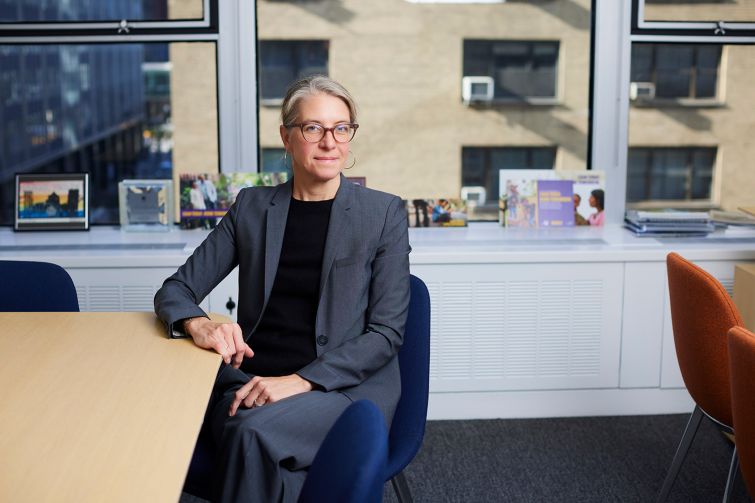NY Housing Commish RuthAnne Visnauskas On Tax Incentives, Basement Apartments
‘We don’t have time for projects to take two, three, four, five years in their entitlement process …’
By Aaron Short November 30, 2023 6:00 am
reprints
Gov. Kathy Hochul sought to tackle New York’s most dire housing crisis in decades by unveiling a plan in January that would build 800,000 homes over the next decade.
State housing commissioner RuthAnne Visnauskas — her official title is commissioner and CEO of New York State Homes and Community Renewal (HCR) — was one of the key architects of that proposal. It would have among other sweeteners incentivized the construction of new units near transit lines in suburban areas and denser residential complexes in urban neighborhoods that have long opposed new development.
Unfortunately, it didn’t work out that way. Once the legislature balked at most of the plan’s measures, Hochul and her team sought to go it alone by passing an executive order permitting tax benefits for stalled development projects in South Brooklyn.
Next year they’ll try again. Visnauskas has been in the middle of discussions for what the governor’s housing priorities would look like. In a late November interview with Commercial Observer, she gave us a preview of what the administration values and how it hopes to create more homes with private sector help for future generations of New Yorkers.
This interview has been edited for length and clarity.
Commercial Observer: How did you get interested in housing policy?
RuthAnne Visnauskas: I have been working in housing for a very long time, both in New York City and in New York state. I started out in the nonprofit sector, working for a nonprofit housing developer in Hell’s Kitchen and have really been invested in working community organizing and housing since then.
What was the nonprofit and what were you doing there?
It was Clinton Housing. I was the director of housing development. I started as a project manager, and then director of a three-person department. They’re a great organization mostly doing preservation of affordable housing.

You worked with Mayor Michael Bloomberg as housing commissioner and with Gov. Andrew Cuomo. How is Gov. Kathy Hochul different from either of them? And in what way?
Obviously, it’s a different environment to work at the state level where the state has 1,525 cities, towns and villages. It’s a much bigger place to really get a handle on local land use issues. The perspective is different, and I think that reflects in the way the administrations run and the things they have control over and the things they don’t, and the impact of the state legislature on the work that you do.
Gov. Hochul has been incredibly committed to housing that’s affordable for people, and at this moment we’re at a real inflection point, talking about all types of housing across the spectrum and not just affordable housing being a key part of making the state successful for future generations.
How much time does Hochul spend on housing policy?
If you have ever heard her speak at a housing event, she pulls from her lived experience about the impact of housing on her family’s success going from a home in a mobile home park, to an apartment building, to a small cape, to a large house as her family got bigger, as her dad got a college education and a job. She’s very sensitive to and aware of the role of housing in people’s lives as it relates to opportunity, stability and community.
She tells a story about Buffalo, where there was a lot of housing and no jobs, and now we’re in a state where there’s lots of jobs but no housing. She feels deeply about making sure the housing production can catch up so people can get on the first rung of the ladder and be stably housed.
How often do you confer with the governor?
Certainly, this time of year, we are ramping up to the State of the State, so there’s a lot of interaction with our agency and the governor’s office, and myself and the governor, as housing issues come up.
We check in I would say regularly on housing policy issues. We don’t have a weekly check-in call. She has a big staff and a big state to manage. We are at a lot of events together and we talk with her team regularly. She still holds cabinet meetings, but those are in addition to meetings we’re having specifically about housing topics, policy and initiatives, and updates on how our strategic plans are going.
At the start of the year, the governor introduced an ambitious housing compact that sought to build 800,000 homes statewide, but the legislature picked it apart. What were the biggest reasons behind its struggles?
What we sought out to do was to be very comprehensive in our approach. There has not been a governor who has really stepped back and taken time to look at what we’ve done over the past 10 years. We created 400,000 units of housing and 1.2 million jobs. That’s not the same for New Jersey or Connecticut, where their housing and job production are more on par and in some cases they are building more housing than they are creating jobs.
The Regional Plan Association felt that we needed to create 800,000 units in the next decade to meet demand, and that’s a doubling of what we’ve done in the past. When we came at it this last year, we sought to create a proposal that was comprehensive. I don’t think we expected we would come out with a whole proposal, but we went into the process saying here’s a series of tools that we think could get there.
Obviously we were not successful with the legislature last year. There are lots of reasons why. Change is hard and it takes a long time for large legislative changes in the state to get through the process. The governor understands it’s a marathon and not a sprint.
She came out in July with a series of executive actions, wanting to do things that are under her own control. It’s reflective of her commitment to the issue, that we increase the amount of housing produced in the state to make us viable and attract the jobs that New Yorkers want and need.
Is there any urgency to try these measures again?
We feel urgency every day. We’re fortunate at this agency that we have so many housing tools across the state in one agency. Not all states run their housing programs the same way. The benefits of having a consolidated housing agency is that we know firsthand how important housing is for everybody and how critical it is. We can feel it and hear it through the interactions that we have in all the different places we touch housing production across the state.
We are under a five-year, $25 billion housing plan. We’re a year and a half into that, and we’re on schedule and on track with that. We feel both pressure and urgency on delivering that commitment to affordable housing but also the need to do so much more than that. It isn’t just the production and preservation of affordable housing that’s going to address the housing crisis in the state. It’s really a much larger issue of more types of housing in more places that we have incredible demand for and that we need to double our production of in order to relieve pressures on the housing market.
What role does the private sector play? Do you meet with groups like REBNY or the Building Trades?
The housing that we are building and preserving and the single-family mortgages we’re providing to first-time homebuyers, and Section 8 vouchers and mobility programs — it’s a public-private partnership. We rely very heavily on nonprofit and for-profit housing sectors in this state to be our partners.
We work in an ecosystem of parties that are involved in all aspects of housing and tenants and management and ownership in the state. We’re really able to understand by virtue of the complexity of the ecosystem itself.
One of the complaints that we hear from developers is that they need an incentive from the state to make affordable housing cheaper to build. How do you get the private sector to start building again?
I would certainly say in the time I’ve been working in New York City that it has gotten more expensive to build. There are lots of things that go into that. Coming out of COVID, there are supply chain issues that have created a lot of increased cost. It is definitely more expensive to build in New York City, and a lot of owners and developers see the land use process and the regulatory process as a part of that cost.
The mayor of New York City through zoning initiatives is attempting to reduce regulatory and governmental barriers that add cost. We don’t have time for projects to take two, three, four, five years in their entitlement process before getting a shovel in the ground. That’s a goal everyone can get behind.
Do you have a role in crafting tax incentives like 421a? What kind of incentive should exist to spur development?
It’s hard to separate out where we are today from the history of development of multifamily rental housing in New York City because 421a has been around for so long. It’s hard to talk about the production of housing, what it would be or could be like in the absence of that, or to shift to property tax reform as an alternative strategy.
Tax exemptions have been in the New York City system for a very long time. They’ve produced an enormous amount of housing over the years. The data shows that over 80 percent of buildings that receive 421a tax exemption in the last decade have been 25 units or less. There isn’t as much focus on the fact that a lot of outer-borough production of rental housing you see is from 421a.
That isn’t what people are thinking about when they think of 421a. People think of very large Manhattan or Downtown Brooklyn rental buildings, which account for more of the units produced. But it’s an incentive in place for a very long time and revamped in the de Blasio administration to support inclusionary housing in the city zoning.
We are very supportive of the city and its efforts to create more rental housing. We will continue to work closely with them on a program that works for them and that they think is viable as it relates to both taxes and affordability. I don’t have a crystal ball into the next budget to know where that will go, but it is certainly a topic of a lot of conversations in the housing world right now.
Could we see tenant-friendly measures like Good Cause Eviction, which aims to prevent large rent hikes and some evictions, tied to it? Or passed separately?
I think that there has been a lot of conversation about that in the last two years, on the heels of the pandemic eviction moratorium. Those conversations came more to the forefront. The legislature has the ability to introduce or pass laws. So it will remain a conversation going into this executive budget season and legislative session whether Good Cause will become part of the overall budget.
Is the governor including Good Cause in those discussions?
I don’t think I would comment on that here beyond saying the external policy conversations definitely include 421a and Good Cause and to what extent they’re linked in a policy agenda. If you go on any housing policy blog space you will find people talking about, “Are they going to introduce 421a or Good Cause, and by extension would the legislature pass either?” These are the questions out there at the moment, and I don’t think there are solid answers to them.
What we do know and what we want to remain focused on as we did last year is this larger conversation around housing supply. And we need to be focused on policy levers and policies that we put forward that will lead to increased housing supply, not at the expense of tenant protections. We are very focused on ensuring tenants stay stably housed. We put a lot of money into preserving affordable housing. But those larger conversations will continue to be a loud part of the conversation as we go into January.
What are you doing about people leaving for other states because of the housing shortage or affordability concerns?
It’s difficult to gauge why families or individuals may move out of New York state. Some may do it to be closer to family, others may do it because of a new job, but no one is necessarily reporting back to us about why they left.
We know the housing crisis in New York is affecting everyone, no matter where you fall on the income scale, but we are working tirelessly to increase the housing supply so that more New Yorkers have the chance to live in affordable and stable homes, with access to jobs and the resources available to help them be successful. I’m proud to say that HCR is directing the governor’s $25 billion, five-year housing plan, which is on its way to creating and preserving 100,000 affordable homes across New York, including 10,000 with supportive services.
We’ve seen the effect of superstorms on housing in flood zones and along the shoreline. With billions being spent on resiliency efforts and insurance premiums spiking, is it viable anymore to incentivize development in these areas?
Importantly, Gov. Hochul is making climate adaptation a major priority. One of the ways we’re doing this is through our Sustainability Guidelines program, which is helping our housing landscape become more climate friendly one project at a time. And I’m proud that since we’ve implemented these standards, several HCR-sponsored projects have been honored for climate-friendly design, like La Mora Senior Apartments in Yonkers, a highly energy-efficient building that achieved Passive House Institute certifications. The Rise, a Vital Brooklyn development, was also recognized by The New York State Energy Research and Development Authority’s Buildings of Excellence competition for its design as a low-carbon-emitting building.
We are also opening programs and funding opportunities that help developers and homeowners make their properties greener and more energy efficient. Our Clean Energy Initiative provides funding incentives and technical support for clean energy projects in new and existing homes. The Weatherization Assistance program makes the transition away from fossil fuels more affordable by reducing heating and cooling costs through energy-conservation measures. And our Climate Friendly Homes fund provides access to funds to support electrification and other energy-efficiency measures in small multifamily properties in economically disadvantaged communities.
Mayor Adams proposed a zoning change for single-room occupancy units that would make them easier to build. Could that work in other parts of the state?
Housing units of all types and sizes have a place in our toolbox to increase supply and affordability. Existing single-room occupancy units are an important aspect of the affordable housing ecosystem, especially for New Yorkers that are eligible for support services such as those who suffer from a mental illness, a disability, chronic homelessness or domestic violence.
New York is committed to creating or preserving 10,000 units of supportive housing as part of the latest housing plan and our Supportive Housing Opportunity Program plays an integral role in meeting this commitment. The program helps finance developments that provide affordable housing and on-site supportive social services for eligible New Yorkers.
What can you do to promote transit-oriented development so housing can be built in areas where it is needed but is opposed by local officials?
We have invested in transit-oriented projects across the state, including a resilient housing project near the train station in Riverhead, Long Island; a mixed-income workforce housing project near the Beacon train station in Dutchess County; and a new supportive housing project built on an underutilized parking lot near the Mott Haven subway stop in the Bronx.
Encouraging the growth of multi-part partnerships can also help increase transit-oriented development. For example, the recently opened Avalon Harrison began as a partnership between the locality, the state, the Metropolitan Transportation Authority, and the development community. The new development near the Harrison MTA station included 140 homes, improved the streetscape to encourage small-business growth on Halstead Avenue, updated station access, public plazas, and parking spaces. These types of partnerships can help produce results and promote cooperation.
What is your office doing to enable accessory dwelling units (ADUs) or legalizing basement apartments?
Accessory dwelling units, like single-room occupancy units, are an important part of our toolbox to increase housing of all types and sizes — we must work to make basements legal as a matter of safety for tenants. This should not be subject to so much disagreement.
ADUs are about giving homeowners choice with their properties to house more people — their kids, themselves, a neighbor — and we should work to give people more choice in making their own housing more affordable.
Our Plus One ADU program will invest $85 million to support low- and middle-income homeowners who want to build a new ADU on their property or improve an existing ADU. They could include detached units, basement apartments or garage conversions.
The program provides grants to localities and nonprofits that are committed to crafting community-specific programs for expanding and improving ADUs so they are following local and state code requirements.
Twenty-three million dollars from the program has already been awarded to nine grantees. Homeowners can receive up to $125,000, which includes the construction, project delivery, and pre-development costs.


